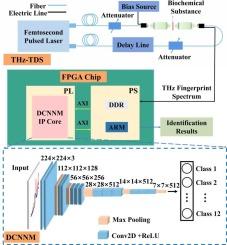On-chip intelligent terahertz sensing platform for real-time intelligent biochemical identification
IF 4.9
3区 工程技术
Q2 ENGINEERING, ELECTRICAL & ELECTRONIC
引用次数: 0
Abstract
This study presents a groundbreaking on-chip intelligent terahertz (THz) sensing platform for real-time biochemical identification, integrating THz time-domain spectroscopy (THz-TDS) with a low-power, embedded deep learning system based on a field-programmable gate array (FPGA) chip. Utilizing a hardware-software co-design approach, the platform deploys a custom-designed deep convolutional neural network model (DCNNM) onto an FPGA chip. This integration enables the real-time, high-specificity identification of 12 distinct biochemical compounds, including amino acids, proteins, and saccharides, achieving a remarkable accuracy of 96.67 % with a sub-second latency of 320 ms per spectrum. Critically, the platform overcomes the challenge of identifying spectrally ambiguous substances lacking distinct THz peaks (e.g., proteins and saccharides) through the proposed DCNNM's advanced feature extraction capabilities, demonstrating transformative potential for point-of-care diagnostics and drug screening. The optimized DCNNM architecture, featuring only 14.7 million parameters, ensures efficient FPGA implementation. The entire system operates at an ultra-low power consumption of 2.97 W, eliminating reliance on offline processing and enabling truly portable, embedded analysis. This innovative approach offers a powerful solution for medical diagnostics, drug screening, and biochemical research, providing a rapid, intelligent, and highly accurate method for biochemical substance identification.

用于实时智能生化识别的片上智能太赫兹传感平台
本研究提出了一种突破性的片上智能太赫兹(THz)传感平台,用于实时生化识别,将太赫兹时域光谱(THz- tds)与基于现场可编程门阵列(FPGA)芯片的低功耗嵌入式深度学习系统相结合。该平台利用硬件软件协同设计方法,将定制设计的深度卷积神经网络模型(DCNNM)部署到FPGA芯片上。这种集成能够实时、高特异性地鉴定12种不同的生化化合物,包括氨基酸、蛋白质和糖类,准确度达到96.67 %,每个光谱的亚秒延迟为320 ms。至关重要的是,该平台通过提议的DCNNM的先进特征提取功能克服了识别缺乏明显太赫兹峰的光谱模糊物质(例如蛋白质和糖类)的挑战,展示了在现场诊断和药物筛选方面的变革潜力。优化后的DCNNM架构仅包含1470万个参数,可确保高效的FPGA实现。整个系统以2.97 W的超低功耗运行,消除了对离线处理的依赖,实现了真正的便携式嵌入式分析。这种创新的方法为医学诊断、药物筛选和生化研究提供了强有力的解决方案,为生化物质鉴定提供了一种快速、智能、高精度的方法。
本文章由计算机程序翻译,如有差异,请以英文原文为准。
求助全文
约1分钟内获得全文
求助全文
来源期刊

Sensors and Actuators A-physical
工程技术-工程:电子与电气
CiteScore
8.10
自引率
6.50%
发文量
630
审稿时长
49 days
期刊介绍:
Sensors and Actuators A: Physical brings together multidisciplinary interests in one journal entirely devoted to disseminating information on all aspects of research and development of solid-state devices for transducing physical signals. Sensors and Actuators A: Physical regularly publishes original papers, letters to the Editors and from time to time invited review articles within the following device areas:
• Fundamentals and Physics, such as: classification of effects, physical effects, measurement theory, modelling of sensors, measurement standards, measurement errors, units and constants, time and frequency measurement. Modeling papers should bring new modeling techniques to the field and be supported by experimental results.
• Materials and their Processing, such as: piezoelectric materials, polymers, metal oxides, III-V and II-VI semiconductors, thick and thin films, optical glass fibres, amorphous, polycrystalline and monocrystalline silicon.
• Optoelectronic sensors, such as: photovoltaic diodes, photoconductors, photodiodes, phototransistors, positron-sensitive photodetectors, optoisolators, photodiode arrays, charge-coupled devices, light-emitting diodes, injection lasers and liquid-crystal displays.
• Mechanical sensors, such as: metallic, thin-film and semiconductor strain gauges, diffused silicon pressure sensors, silicon accelerometers, solid-state displacement transducers, piezo junction devices, piezoelectric field-effect transducers (PiFETs), tunnel-diode strain sensors, surface acoustic wave devices, silicon micromechanical switches, solid-state flow meters and electronic flow controllers.
Etc...
 求助内容:
求助内容: 应助结果提醒方式:
应助结果提醒方式:


